by John Chenery
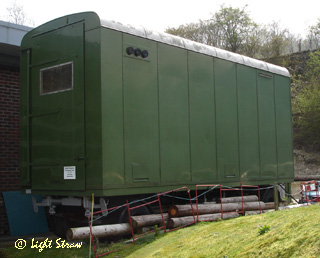 |
Over the years, a variety of mobile exchanges were built to provide extra exchange capacity where it was most needed and to give emergency cover in the event of a disaster. Typical equipments fitted ranged from special UAX variants, Non-Director to TXE2 as well as containerised Digital and customer switch replacement modules. |
The very first Mobile Automatic eXchange (MAX) was brought into service in 1938 by the Postmaster General, Major G.C. Tryon, M.P. who made the inaugural call from Post Office Headquarters to the chairman of Essex County Council in Chelmsford. After the ceremony, the exchange was then put to work in North Weald, Essex where it replaced a small manual exchange.
MAX - Mobile Automatic Exchange
The early MAXs housed No. 12 type equipment with provision for 100 lines - 90 subs. and 10 junctions. The mobile had many special features:-
Trailer Design
|
Once on site, the pneumatic tyred wheels would usually be replaced by heavy cast steel feet, bolted directly onto the wheel axles.
Exchange Design
|
MAX12s were often used to provide service during the conversion from manual working while the permanent auto exchange was being constructed. Typical setting-up time including diversion of local cabling was 2 weeks.
MAX13s were the mobile version of the UAX13 with a capacity of up to 200 lines.
By 1955, 29 MAX 12s (serials 1-29) had been allocated to the GPO Regions. As well as 11 MAX 13s, (serials 1001-1011).
Whereas MAXs were used predominantly for rural areas and to aid the conversion from manual to auto working, the demand for telephone service was increasing and a larger capacity expedient was needed.
TASS Mobiles
In 1954 the Teleprinter Automatic Switching Service (TASS) for the transmission of telegrams across the UK was completed. It served 500 telegraph offices. In 1955 two mobile units were provided as emergency switching allowing for 100 station lines and 70 trunks contained in two trailers. Mobile VF telegraph equipments providing 84 channel circuits in one trailer were also on order.
The New Mobiles
As Subscriber Trunk Dialling (STD) started to be introduced in the 1960s and the demand for telephone service increased dramatically, the MAX 12s and 13s were no longer suited to provide either sufficient lines or code routings.
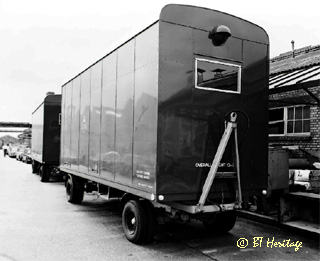 |
Two new style mobiles were designed; the MNDX (a subscribers' unit) and the MTX (a tandem unit). |
|
MTXs utilised some of the equipment within the MNDX, so could not be used in isolation. In the late Sixties, MTXs were produced at the Post Office Factory at Birmingham.
By 1965, 35 MNDXs (serials 1-35) and 7 MTXs (serials 1-7) had been allocated to the GPO Regions. In 1971 an additional 200 MNDXs (serials 200-399) were on order. Eighteen MNDXs of this batch were constructed by the Post Office Factories, while 182 were constructed by the Regions. An additional 40 MTXs were also on order.
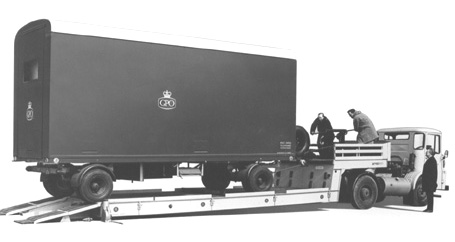 |
Later models of the new mobiles had smaller pneumatic or solid tyres, suitable only for transportation by low-loader. |
MXE2 Types
The first mobile TXE2 designated MXE2, was operational in 1973 at Padgate, Lancashire to cater for growth in Warrington new town.
Many MXE2s were equipped at Plessey's factory in Beeston, Nottingham. Key features were:
|
Logos and Serials
| POST OFFICE ENGINEERING DEPT. TELEPHONE MANAGER |
GPO | POST OFFICE TELEPHONES TELEPHONE MANAGER |
Mobiles were finished in mid-bronze green and allocated sequential unit numbers in white lettering together with 'POST OFFICE TELEPHONES' or 'POST OFFICE ENGINEERING DEPT.' as well as, the superfluous 'TELEPHONE MANAGER' as many mobiles were used nationally and not assigned to particular Areas. The GPO logo complete with crown was also used for some time after the Post Office ceased to be a government department.
MNDX1 carried trailer serial number T11892. Telecoms trailer serial numbers T205000-T207418 were used between 1965 and 1971. Thereafter, the 9 digit telecom vehicle identification numbers were used.
Thus for MNDX No. 331 serial 71 830 0030 the details are as follows:
| 71 | 830 | 0030 |
| Year of Delivery | Mobile Telephone Exchange | Unit Serial Number |
1971 is the year of delivery (but not necessarily when the racks were fitted). The 830 refers to mobile telephone exchanges and the 0030 is the unit serial number.
Between 1971 and 1981, serials 830 to 834 were also used to designate:
|
Containerisation
In the early Eighties, British Telecom's Teletrade produced complete Strowger exchanges in insulated, air conditioned standard 20-foot containers for export overseas. The basic unit was 400 lines capacity. Lettering was British Telecom blue on a yellow container. Containerised 'reed switching systems' were also produced by Plessey for both the home and export markets.
Commsure
Commsure was devised by Phil Taylor in response to customer demand for an emergency (PABX) switch replacement service that could be used in the event of a fire or other major disaster at a business premises. This was necessary as the Stored Program Control PABXs in use during the Eighties took many months to order and to program to customer's requirements. The idea was adopted by British Telecom North East in 1984 and the first units were ready by February 1985. Commsure units were:-
|
The TXD
The world's first transportable System X telephone exchange was delivered on 1st April 1987 to BT's East Anglia District as an expedient to cater for the rapid expansion of the Port of Felixstowe. Supplied by Plessey Major Systems Ltd of Liverpool, the RCU (Remote Concentrator Unit) with a capacity of approximately 1500 lines, was housed in a standard 30-foot container which was positioned by a heavy lift 'Quinto' crane. The exchange keys were handed to EAD's District Manager, Colin Coleman by Plessey's Paul Leidecker.
Later Histories
The Nineties saw the end of the analogue exchanges with the majority of the Strowger and Electronic mobiles having been stripped-out for use as storage units, mobile shops and other purposes. Fully-equipped surviving units are rare, but examples can be seen at museums and preserved railways.
By the year 2000, mobile units could be used for conceivably any purpose ranging from a complete Personal Computer (PC) equipped office, Internet node, mainframe system, satellite up-link and broadcast facility, as the various communications medias continued towards convergence.
MIUs
In 2003, new Mobile Infrastructure Units, housed in custom-built containers and equipped by Fijitsu Telecommunications Europe were the latest in disaster recovery planning by BT. Weighing 14 tonnes, the units had a capacity to support 2000 ADSL (Asymmetric Digital Subscriber Lines) connections.
Mobile DSLAMs
The rollout of fibre broadband (Fibre to the Cabinet) in 2010 introduced complex electronics to new roadside cabinets
as DSLAMs (Digital Subscriber Line Access Multiplexers) were remotely sited from telephone exchanges. To guard against prolonged outages in the event of damage caused by road traffic accidents, mobile DSLAM trailers can be deployed as necessary.
2012 Olympics
At Eton Dorney a disaster recovery container (The Hub) was shipped to the area to provide the additional exchange capacity for communications during the Games.
Preserved Mobiles
 |
Several mobiles have been preserved and restored as a complete working exchange. Others have been rewired or re-equipped, but for many only the trailer survives. |
| Build Data | |
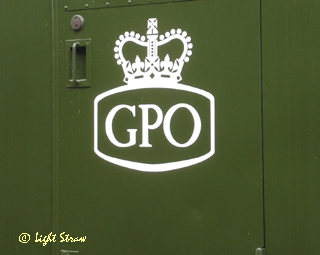 |
Build Data: Serial numbers, exchange types and initial allocation of units. |
| London Test Section | |
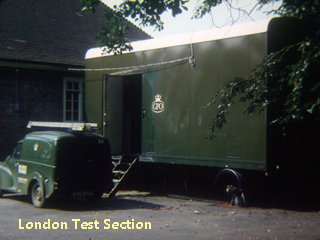 |
A collection of photos by the late Dave Fairhurst who, along with other London Test Section colleagues, carried out the commissioning of the Mobile Exchanges, which were built at the GPO factory in Bilton Way, Enfield. |
Telephony by Atkinson; Chris Barlow; Mike Fletcher; Martin Loach; Peter Walker; Post Office Telecommunications Journals; Telephone Museum, Milton Keynes & Phil Goodwin; Post Office Vehicle Club; THG; Teletalk, staff newspaper of EAD.
References:
POEEJ Vol 31 October 1938 - Inauguration of the First Mobile Unit Automatic Exchange.
POEEJ Vol 32 April 1939 - A Mobile Automatic Telephone Exchange by R.W. Palmer and G.A.O. Abbott
POEEJ Vol 42 July 1949 - A 200-Line Mobile Automatic Exchange by E. Siddall and A.A. Page.
Engineering Instruction A3216 Oct 1968 - Mobile Non-Director and Tandem Exchanges.
All logos and trade marks are the property of their respective owners and are used on the Light Straw site(s) for review only. Students and researchers are recommended to make their own independent enquiries as to the accuracy of the information contained therein.